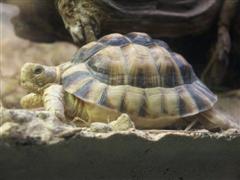Egyptian Tortoise
Klein's Tortoise, Kleins Tortoise, Egyptian Dwarf Tortoise Scientific Name: Testudo kleinmanni
Sat, 26th April, 2025 - 10:51 am GMT
Sponsor Ads:

Alternative Name
Klein's Tortoise, Kleins Tortoise, Egyptian Dwarf Tortoise Scientific Name: Testudo kleinmanniBasic Info
One of the smallest species of tortoises, female Egyptian Tortoises rarely exceed five inches and males are usually four inches or less in carapace length. Males can be distinguished from females by the longer tails and smaller size.
Health
The enclosure of the Egyptian Dwarf Tortoise should not be maintained below the mid 70s (Fahrenheit). These tortoises do best when maintained at about 75 - 80 degrees Fahrenheit with a warmer area of the cage about 90 degrees. They need a large enclosure, despite their small size, because they are quite active. In captivity, they often eat leafy greens, roses, hibiscus, dandelion, tree mallow leaves, grape leaves, grated carrot, and sweet potato. Water must be placed in a shallow, heavy dish in a location that is easily accessible. They will also get some water from their diets. Ideally, if one lives in the appropriate environment they should be kept outdoors for at least part of the year. When housed indoors, they must be exposed to full spectrum UV lighting for about 13 hours a day. Breeding It can be a bit difficult to breed Egyptian Dwarf Tortoises in captivity. Not everyone is successful when attempting to breed this species, and little is known about the breeding habits and requirements of this species. It is known that males vocalize during mating. Males are also smaller and have longer tails than females.Habitat
Found on semi-desert and coastal regions of the Near and Middle EastBehavior
The Egyptian Tortoise is a very small breed of tortoise that is also known as the "Egyptian Dwarf Tortoise" or the "Klein's Tortoise". The Egyptian Tortoise can usually be found on semi-desert and coastal regions of the Near and Middle East. They are herbivores, and therefore maintain a diet of plants. Sadly their diet is being threatened by overgrazing and habitat destruction.The Egyptian Tortoise, unlike many other breeds, remains active throughout the winter. In fact, they do not do well in hot weather and often estivate during the summer. The Egyptian Tortoise is not common in the pet trade. This may be due to the fact that when they were coming in as wild imports they had a tendency to have poorer health and henceforth would often die. For this reason they were often considered "difficult to keep". Now that they are being bred in captivity or are long term captives they are considered easier to keep.Origin
AfricaHistory
The population of Egyptian Tortoises is severely threatened by a variety of sources. While traditionally found throughout the arid deserts around the Mediterranean Sea, extending from Israel to Libya, they have been forced out of many of their natural homes by predation, overgrazing, and development. Much of the tortoise's habitat is being destroyed by agriculture. Plowing eliminates much of the vegetation the tortoises feed on, as well as destroying the cover and the substrate. Besides destroying the habitat, the plowing likely kills the tortoises as well. The surviving animals must move to habitats that still exist, and compete with each other and other species for food and cover. Even in areas where the habitat remains, the tortoises must compete with much larger animals such as sheep and goats for food. When the area has been overgrazed, there is no food for the tortoises. Egyptian Dwarf Tortoises are also threatened because of collection. While the collection of the Egyptian Dwarf Tortoises has decreased in recent years, in the past they were collected for the pet trade quite heavily.Common Foods
Their favorite foods include saltwort and sea lavender, which they use for hiding as well.Sponsor Ads:
"As far as the laws of mathematics refer to reality, they are not certain, as far as they are certain, they do not refer to reality." -- Albert Einstein
Egyptian Tortoise
Coded by: BGID® | ALL RIGHTS RESERVED Copyright © 2000-2025
Disclaimer | Privacy | Report Errors / Contact | Credits








 President of the United States of America - Real Estate mogul, Pageant owner and now one of the most controversial men in political history.
President of the United States of America - Real Estate mogul, Pageant owner and now one of the most controversial men in political history.  Politician, US Vice President and President of the USA - Joseph Robinette Biden Jr.
Politician, US Vice President and President of the USA - Joseph Robinette Biden Jr.  versus
versus  Russia: 'The Evil Empire'? Are they all that bad or is it just the USA trying to portray Russia as bad because they are a world power with land bigger and a society very different from the USA ideal?
Russia: 'The Evil Empire'? Are they all that bad or is it just the USA trying to portray Russia as bad because they are a world power with land bigger and a society very different from the USA ideal?  Global warming has been in and out as the "latest" hot topic for many years. It is, according to modern scientists, the result of man-made industrial pollutants, clearing forested areas, agriculture, etc. But now they are thinking it started way before the Industrial Revolution...
Global warming has been in and out as the "latest" hot topic for many years. It is, according to modern scientists, the result of man-made industrial pollutants, clearing forested areas, agriculture, etc. But now they are thinking it started way before the Industrial Revolution... 
 Corona virus
Corona virus 
 Users with wide screen monitors can benefit from more content on every page.
Users with wide screen monitors can benefit from more content on every page.